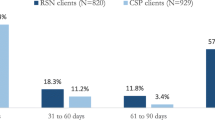Abstract
To explore whether the implementation of performance-based contracting (PBC) within the State of Maine’s substance abuse treatment system resulted in improved performance, one descriptive and two empirical analyses were conducted. The first analysis examined utilization and payment structure. The second study was designed to examine whether timeliness of access to outpatient (OP) and intensive outpatient (IOP) substance abuse assessments and treatment, measures that only became available after the implementation of PBC, differed between PBC and non-PBC agencies in the year following implementation of PBC. Using treatment admission records from the state treatment data system (N = 9,128), logistic regression models run using generalized equation estimation techniques found no significant difference between PBC agencies and other agencies on timeliness of access to assessments or treatment, for both OP and IOP services. The third analysis, conducted using discharge data from the years prior to and after the implementation of performance-based contracting (N = 6,740) for those agencies that became a part of the performance-based contracting system, was designed to assess differences in level of participation, retention, and completion of treatment. Regression models suggest that performance on OP client engagement and retention measures was significantly poorer the year after the implementation of PBC, but that temporal rather than a PBC effects were more significant. No differences were found between years for IOP level of participation or completion of treatment measures.
Similar content being viewed by others
Notes
Although length of stay and completion of treatment measures were both available as possible outcome measures for OP and IOP services, management decided to partner length of stay with number of sessions for OP retention measures and to partner completion of treatment with number of days in treatment for IOP retention measures. As length of stay in OP programs was typically brief, providers had communicated to the state agency that they felt length of stay would be a better outcome indicator for a 4 to 6 weeks’ OP program. In addition, OP had some clear national indicators that were appropriate to use as benchmarks whereas IOP did not.
Linear regression models were also run. PBC was not significant in any of the models. Results are available from authors.
References
Backer, TE. (1988). Research utilization and managing innovation in rehabilitation organizations. Journal of Rehabilitation, 54(2): 18–22.
Lehman, W. Greener, J.M., and Simpson, D.D. (2002). Assessing organizational readiness for change. Journal of Substance Abuse Treatment, 22(4): 197.
Institute of Medicine (1990). Treating drug problems. (1990). Washington, DC: The National Academy Press, 1990.
Institute of Medicine (2006). Improving the quality of health care for mental and substance-use conditions. Washington, DC: The National Academy Press.
Commons, M., McGuire, T., and Riordan, M. (1997). Performance-based contracting for substance abuse treatment. Health Services Research, 32(5):631–50.
Lu, M., and Ma, A. (2006). Financial incentives and gaming in alcohol treatment. Inquiry, 43(1): 34–53.
Shen, Y. (2003). Selection incentives in a performance-based contracting system. Health Services Research, 38(2): 535–552.
Lu, M., and Ma, A. (2002). Consistency in performance evaluation reports and medical records. The Journal of Mental Health Policy and Economics, 5(4): 141–152.
Maine Office of Substance Abuse (2008) Block grant application to federal Substance Abuse and Mental Health Services Administration. Maine Office of Substance Abuse, Augusta
McCarty, D., Gustafson, D.H., Wisdom, J.P., et al. (2007). The Network for the Improvement of Addiction Treatment (NIATx): Enhancing access and retention. Drug and Alcohol Dependence, 88: 138–145.
Wickizer, T., Maynard, C. Atherly, A et al. (1994). Completion rates of clients discharged from drug and alcohol treatment programs in Washington State. American Journal of Public Health, 84(2):215–221.
Linn, M. (1978). Attrition of older alcoholics from treatment. Internal Journal of Addictions Disorders, 3:437–447.
Jones, JW. (1985). Predicting patients’ withdrawal against medical advice from an alcoholism treatment center. Psychological Rep, 57:991–994.
Hahn, J and King, K. (1982). Client and environmental correlates of patient attrition from an inpatient alcoholism treatment center. Journal of Drug Education, 12:75–86.
Sansone, J. (1980). Retention patterns in a therapeutic community for the treatment of drug abuse. International Journal of Addiction, 25:1–26.
Festinger, D.S., Lamb, R.J., Marlowe, D.B. et al. (2002). From telephone to office: Intake attendance as a function of appointment delay. Addictive Behaviors, 27: 131–137.
Maddux, J.F., Desmond, D. and Esquivel, M. (1995). Rapid admission and retention on methadone. American Journal of Drug and Alcohol Abuse, 21(4): 533–547.
Stark, M.J., Campbell, B. and Brinkerhoff, C. (1990). Hello, may we help you? A study of attrition prevention at the time of the first phone contact with substance-abusing clients. American Journal of Drug and Alcohol Abuse, 16(1&2): 67–76.
Acknowledgement
A portion of the work on this study was completed through funding from the National Institute on Drug Abuse Brandeis/Harvard Center on Managed Care and Drug Abuse Treatment (P50-DA10233).
Author information
Authors and Affiliations
Corresponding author
Rights and permissions
About this article
Cite this article
Brucker, D.L., Stewart, M. Performance-Based Contracting Within a State Substance Abuse Treatment System: A Preliminary Exploration of Differences in Client Access and Client Outcomes. J Behav Health Serv Res 38, 383–397 (2011). https://doi.org/10.1007/s11414-010-9228-5
Published:
Issue Date:
DOI: https://doi.org/10.1007/s11414-010-9228-5



